Ludzīlazest: Who are the Lutsis?
Finnic speakers in Latvia
Finno-Ugric languages have been spoken in the Baltic area for several thousand years. Perhaps the most well-known Finnic speakers in Latvia are the Livonians. Their community once stretched along the Gulf of Rīga and into Vidzeme, retreating over the course of the centuries with the last known speakers of Vidzeme Livonian recorded in the village of Svētciems near Salacgrīva in the 1860s and the Kurzeme Livonians remaining in a string of villages in extreme northern Kurzeme until World War II, after which they were scattered to other parts of Latvia and among the members of the Latvian refugee community abroad.
Still, other Finnic nations are to be found in modern times in Latvia. The Krevins (from Latvian krieviņi ‘Russians [diminutive]’) were speakers of Vote and lived near Bauska from about 1445 when they were moved as prisoners of war from western Ingria to this area by the Duchy of Novgorod. The language of the Krevins was still spoken sufficiently to be recorded by Johan Andreas Sjögren in the mid-19th Century before becoming extinct soon thereafter.
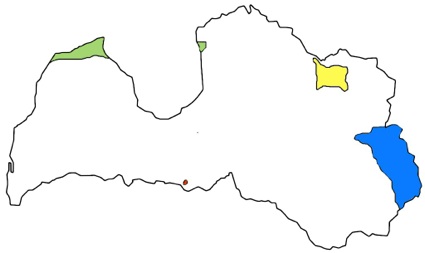
Approximate distribution of Finnic-speaking groups in Latvia
in the mid to late 19th Century
(blue=Lutsi, yellow=Leivu, green=Livonian, red=Krevin Vote)
The Estonian Language Islands
In Latgale, Eastern Latvia, there are the so-called Estonian or South Estonian language islands. There are three communities that are generally grouped under this term. These are called: Lutsi, Leivu, and Kraasna. All three communities spoke dialects of South Estonian and the South Estonian varieties of all three communities are no longer spoken.
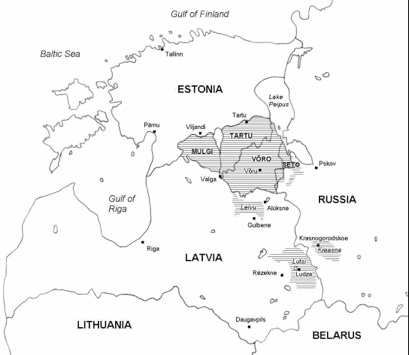
The Estonian language islands (Lutsi, Leivu, Kraasna)
and dialect divisions of South Estonian
(original image by Sulev Iva)
While language shift was ongoing in the twentieth century, the complete shift to other local languages is a relatively recent development. The last speaker of Leivu died in 1988, the last speaker of Kraasna most likely died before World War II. Lutsi was the last to lose its final speaker, Nikolājs Nikonovs, who died in 2006. In the course of my work, I have visited around 40 of the 53 villages noted by Oskar Kallas as having Estonian (i.e. Lutsi) speakers in 1893. Even in villages where residents have no memory or knowledge of their Lutsi roots, their last names will be indicative of a connection with the Lutsis. Some knowledge of these languages remains among descendants. In my experience meeting with Lutsi descendants, I have found that the majority of language knowledge today is in the form of individual words (e.g. suzī ‘wolf’, hopen ‘horse’), greetings (tere! ‘hello’), and very rarely short phrases (ole-eiq! ‘there isn’t/aren’t any!’). There are 1-2 people remaining who could be termed partial speakers of Lutsi, as they have a passive understanding of Lutsi. The extent of their proficiency is difficult to gauge without more fluent speakers to engage with these partial speakers.
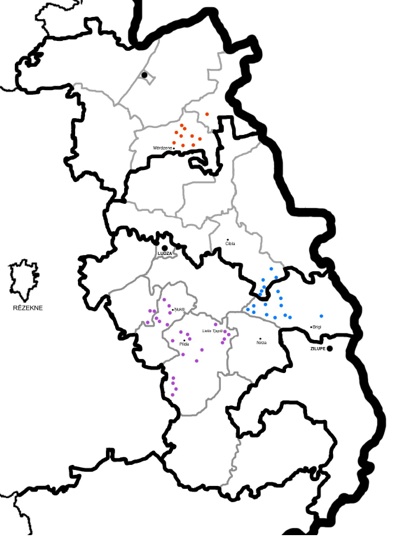
Map of Lutsi villages in the 1890s with present-day administrative boundaries
(black lines=municipality [novads] boundaries, grey lines=parish [pagasts] boundaries)
(purple=villages of the Pilda group, blue=villages of the Nirza group,
orange=villages of the Mērdzene group; map by Uldis Balodis)
In conversing with non-Lutsi-speaking Lutsi descendants presently, it appears that there is genuine awareness among descendants of their Lutsi-speaking ancestors. For middle-aged Lutsi descendants in 2014, their last Lutsi-speaking relative is usually in their grandparents’ or great-grandparents’ generation. The exceptions to this arise in the village of Lielie Tjapši (Jānikülǟ, in Lutsi) near Pilda south of Ludza. (Lielie Tjapši is identified on the above map and is located in the extreme eastern part of the Pilda village group.) This is the last spot where Lutsi was actively spoken by descendants of the community documented by researchers in the 19th and 20th centuries. Antoņina Nikonova, the grandmother of the final speaker of Lutsi, Nikolājs Nikonovs, is remembered by researchers and laypeople alike as being a vibrant and enthusiastic speaker of Lutsi. She died in the 1980s; however, until her passing, she would continue to actively speak Lutsi with her grandson regardless of the absence of speakers elsewhere.
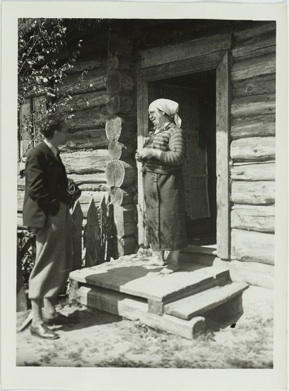
Antoņina Nikonova speaking with linguist Paul Ariste
(photo: V. Niilus, 1936, Lielie Tjapši, Latvia, ERM_754_110)
Theories of Lutsi Origins
There is evidence for more ancient Finnic habitation in Latgale. Antons Breidaks discusses this in his 1981 article (Baltijas somu un latgaļu-seļu etnolingvistisko sakaru jautājumi) discussing the ancient connections between the Baltic Latgalians and Selonians with Finnic tribes in Latgale. And therefore logically there is some difference of opinion regarding the communities that make up the Estonian language islands. Following traditional methods such as studying family lines based on family names is problematic in Latgale, where generally family names were only given to people in the 1860s. Language similarities between Lutsi and the language of other South Estonian speakers is considerable enough that a separation of only a few centuries seems likely. However, the linguistic heterogeneity of the Lutsi community itself suggests multiple migrations – not just a single migration. Still, there are two schools of thought on this subject – those considering the Lutsis to be descendants of an ancient Finnic community in Latgale, and those that consider the Lutsis to be descendants of one or more migrations from South Estonia to Latgale during the course of the last several centuries.
Popular theories for the Lutsis’ origin in more recent centuries include them having been war refugees from the Great Northern War or Catholic Estonians who fled southeastern Estonia during the time that Estonia was under the control of the Protestant Swedes. Previous researchers have noted that some Lutsis have referred to the place of their origin as “the land of the Swedish king”. Several stories also have been retold by the Lutsis as to their origins. One is that two manor lords were gambling. The losing manor lord had wagered several villages of his Estonian peasants and therefore they ended up in the land of the winning manor lord near Ludza. Another story is that a manor lord traded two good hunting dogs for several villages of Estonian peasants who were the ancestors of the present-day Lutsis. Perhaps some or all of these stories are true and they need not account for the origin of all Lutsis in the Ludza area. Multiple migrations seem likely and even in my own work I have seen evidence of this. For example, a Lutsi descendant showed me land deeds from the nineteenth century showing that her ancestors had actually come to the Ludza area only in the latter quarter of that century.
Oskar Kallas and Heikki Ojansuu: Early Descriptions of the Lutsis
The Lutsis have been studied since the end of the nineteenth century. The first extensive account of the Lutsi and also Kraasna communities comes from Oskar Kallas. Kallas travelled the area extensively in 1893 and published a summary of his documentation in several volumes in Estonian with German-language versions of some of these books published separately. For the Lutsis his most important work is his 1894 Lutsi maarahvas. This volume gives a snapshot of what the situation was like at the time. Kallas records the presence of Estonian (i.e. Lutsi) speakers in 53 villages across four parishes (Latvian pagasts, Estonian vald) – Mihalova (after 1925, Mērdzene), Pilda, Nirza, Janovole (after 1925, Brigi). Already at this time Estonian (i.e. Lutsi) was least spoken by people in Mērdzene parish. In my own journeys through the Mērdzene area, I have found that the last names of some of the people living there are the same as those of Lutsi speakers or known descendants documented by earlier researchers, but that knowledge of Estonian (i.e. Lutsi) origin is virtually absent among the people with whom I have spoken.
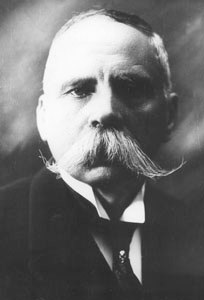
Oskar Kallas (Image source)
In the decades that followed several other researchers documented the Lutsis and their language. In 1911, Heikki Ojansuu documented a great deal of Lutsi language material – primarily in the villages near Pilda, but also to a lesser extent near Nirza and Janovole. Ojansuu also documented the Leivu language during this same period.
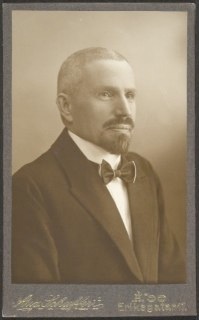
Heikki Ojansuu (Image source)
Paulopriit Voolaine and August Sang: Lutsi Documentation and Differing Views on Lutsi Futures
Prior to World War II, the two most significant researchers of the Lutsis were August Sang and Paulopriit Voolaine. Sang and Voolaine began visiting the Lutsis during about the same time period. Sang produced several extremely valuable studies on Lutsi morphology and phonology. As is also the case for Estonian and Livonian, while the Lutsi noun case and verb conjugation systems are not unusual relative to other Finnic languages or even neighboring Indo-European languages, such as Latvian or Russian, Lutsi has undergone considerable phonological change and reduction. Thus, unlike Finnish, which could be seen as being more agglutinating than fusional in its morphology, Lutsi is far more fusional than agglutinating. Thus, as in Livonian and Estonian, knowledge of declension and conjugation “types” is key in describing Lutsi and being able to learn or teach Lutsi. Nouns of the same type will show the same internal vowel and consonant changes in their declensional paradigm, and verbs of the same type will show the same internal vowel and consonant changes as they are conjugated. Sang made great headway in this work by recording the declensional paradigm of 98 nouns and the conjugation paradigm of 82 verbs in Lutsi.
Voolaine began his work with the Lutsis as a young man but continued this work throughout the course of his entire life. He documented spoken Lutsi both in writing and in the form of audio recordings and also did some linguistic analysis of his own. For Voolaine, Lutsi was a life-long passsion. He also visited the other Estonian language islands; however, his main work was with Lutsi. In reading Voolaine’s work and examining his documentation, one can see that his interest in Lutsi extended beyond just the scientific. He was invested in helping the Lutsis realize their own identity and also to ensure that this identity persisted into the future.
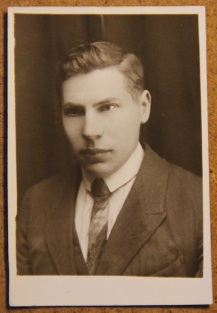
Paulopriit Voolaine (1929, EKM)
On this point Voolaine and Sang had some difference of opinion. Or, at least, Sang stated his feelings on this matter more starkly. Sang felt that the most logical course ahead for the Lutsis was full assimilation into the local Latvian population. This assimilation was well underway in the 1930s and Sang thought that the choice that the Lutsis had was either to assimilate and become part of a more prosperous modern Latvia or to attempt to hold on to their Lutsi language and culture and become a sort of living ethnographic museum – disconnected from the rest of the world and frozen in time.
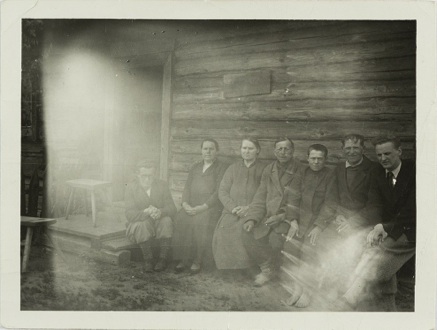
Linguists August Sang (left) and Paul Ariste (right)
with the Lutsi-speaking Jarošenko family
(photo: V. Niilus, 1936, Lielie Tjapši, Latvia, ERM_754_114)
Voolaine made his views apparent through his actions. Prior to World War II he worked to connect the Lutsis with Estonians and to raise awareness of the existence of the Lutsis among the general Estonian population. He did this in part by writing articles on the Lutsis for the Estonian newspaper Postimees and organizing cultural connections between the Lutsi community and Estonia. He took a particular interest in forming these connections for Lutsi children. He organized Estonian Christmas celebrations for children in villages such as Greči near Nirza east of Ludza. Benefactors in Estonia would send Christmas gifts to Lutsi children. In 2014, there are Lutsi descendants who still remember Voolaine and these Christmas celebrations from their childhood.
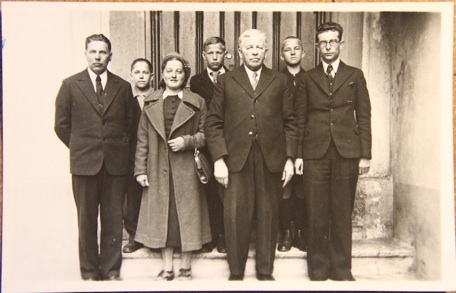
Paulopriit Voolaine (left) with Lutsi boys (back row)
who had gone to study in Estonia (EKM)
Voolaine also was invested in forming educational connections for Lutsi children and young people with Estonia. However, this brought with it its own unique problems. Several Lutsi boys were sent to study in Estonia and returned speaking standard Estonian, but no longer being able to converse with their parents in Lutsi with these families having to switch to using Latvian with each other as a result. Thus the Lutsis found themselves in a uniquely difficult situation relative to their native language. Other Finnic peoples in Latvia, such as the Livonians, had also gone and studied in Estonia, but did not experience this same kind of language loss. Perhaps for the Lutsis the difficulty was that they did not have a clearly-defined and unique identity as the Livonians did. Thus both in Latvia and Estonia the Lutsis were “a type of Estonian”. In Latvia this was sufficient enough to give them room to speak their language without losing it, as long as they did not switch completely to Latvian. As with the Livonians, in principle the Lutsis could have existed in a kind of stable bilingualism speaking their own language, as well as, Latvian. However, in Estonia, as “a type of Estonian”, the Lutsis may have been under pressure to conform to Estonians’ own understanding of what it means to be Estonian. So as an Estonian person from the Latvian countryside speaking an odd and unfamiliar dialect, those young Lutsis may have been under pressure to conform and simply model the kind of Estonian identity they saw around themselves. And ultimately, while Lutsi is quite different from literary Estonian, it isn’t as different from literary Estonian as Livonian is. Thus there was also less of a linguistic “buffer” between the Lutsis and other Estonians, which could have allowed them to more easily exist as stable speakers of both Lutsi and literary Estonian.
Voolaine also lobbied to have Estonian taught at a school in the Lutsi region. Records of his correspondence at the Estonian Literary Museum (Eesti Kirjandusmuuseum) show that he had thought about how to write Lutsi in a practical way for actual use by laypeople, not just linguists. There exist letters written to Oskar Kallas, who had gone to work in the Estonian diplomatic service. These letters are all written to Kallas either by Voolaine or by Lutsi community members along with Voolaine. They are written in Lutsi in an orthography that is based on Estonian. There are also stories that Voolaine may have been working on a manuscript of a Lutsi reading book or instructional book, but no copies of such a manuscript are known to exist.
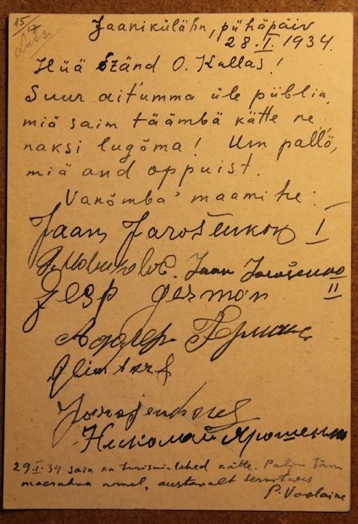
Letter written in Lutsi by Lutsi speakers from Lielie Tjapši
and Voolaine to Oskar Kallas (EKM)
Throughout the Soviet period until his death in the 1980s in an auto accident, Voolaine continued to come to Latgale and document Lutsi. He was in close contact with the Nikonovs family in Lielie Tjapši, among them the final native speakers of Lutsi, until his death and appears in many photos in their family photo album from that time.
Hannes Korjus: Modern Documentation
Since 2000, one of the primary researchers and documenters of the Lutsis has been Hannes Korjus who has published extensively on not just the Lutsi community but on the history and state of the Estonian community in Latvia in general. In 2003, Korjus published a book of Lutsi fairy tales translated into Latvian. More recently in 2011, he published a study on the Estonians of Latvia called Lätimaal eestlasi otsimas (Searching for the Estonians of Latvia). His extensive study of the Estonians of the former Ludza District (Ludzas rajons, in Latvian; this administrative unit ceased to exist in 2009, but encompassed the entire region historically inhabited by Lutsi speakers) conducted in 2001 is unpublished, but is an indispensable resource to all those interested in all people of Estonian descent in this part of Latvia. Korjus’ work on the history and present-day state of the Lutsi community is ongoing.

Hannes Korjus (photo: Uldis Balodis, Korneti, Latvia, August 2013)
Uldis Balodis: The Lutsis in the mid 2010s
I began my research on the Lutsi community in April of 2013. Since that time I have visited about 40 of the 53 villages that Kallas visited in 1893. I have found that nearly all of these villages still are inhabited to some extent presently. Some show more recent development and seem likely to survive at least for some years into the future, other villages are barely inhabited and may disappear in the next few years, while some villages are already entirely gone. One such example is Ščastļivi (Täti külǟ, in Lutsi) which was once one of the main Lutsi-speaking villages in the pre-WWII Nirza parish (Nirzas pagasts, in Latvian). Voolaine spent time there and a number of photographs can be found from there in the 1930s in archives such as that of the Estonian National Museum (Eesti Rahvamuuseum), showing newly built houses and their residents. When I attempted to visit Ščastļivi during the summer of 2013, I found the village to be gone and its former site to be inaccessible by any road.
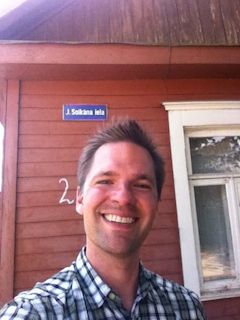
Uldis Balodis by the street named for his
great-grandfather and possible Lutsi descendant
(Ludza, Latvia, August 2012)
Still, much to my fascination, I have found that the area where Lutsi was spoken only a few decades ago, still appears to be inhabited by descendants of the Lutsis. Latvia underwent a great deal of upheaval during World War II passing between Soviet, Nazi, and again Soviet occupations. Latvia lost a great deal of its civilian population due to the war. Yet I found that in some areas knowledge of Lutsi heritage was still present. People with known Lutsi last names were aware of their heritage and occasionally still knew a word or two of Lutsi they had overheard their grandparents use. In other areas where the residents themselves had no knowledge of having any Lutsi ancestry, they often would have last names suggesting that they were in fact of Lutsi descent, even if their families were no longer aware of this.
So, currently there are mostly hints of language knowledge remaining with a broader awareness of Lutsi descent among some members of the community of Lutsi descendants. Everyone has shifted to speaking Latvian, Latgalian, and/or Russian, which are the predominant languages in this region of Latvia.
Abbreviations:
EKM = Eesti Kirjandusmuuseum (Estonian Literary Museum)
ERM = Eesti Rahva Muuseum (Estonian National Museum)














Sources:
Breidaks, Antons. 1997. Ethno-linguistic Contacts between Lettgallians and Selonians and Baltic Finns. Humanities and
Social Sciences Latvia 3 (16). Rīga: University of Latvia. 91-113.
Kallas, Oskar. 1894. Lutsi maarahvas. Helsinki: Suomalaisen Kirjallisuuden Seura.
Korjus, Hannes. 2001. Ludzas rajona igauņi 2001. gadā. Latviešu folkloras krātuves arhīvs, LKF Nr. 2116. 6. tabula.
______________, ed. 2003. Ludzas igauņu pasakas. Rēzekne, Latvia: Latgales Kultūras Centra izdevniecība.
______________. 2011a. Zemes ķēniņa dēls neatgriezīsies. Lätimaal eestlasi otsimas. Tallinn: Kadmirell.
______________. 2011b. Lätimaal eestlasi otsimas. Tallinn: Kirjastus Kadmirell.
______________. 2013. Kaut ko par Ludzas igauņu senčiem un pēcnācējiem. Unpublished manuscript
Pajusalu, Karl. 2009. Estonians of Latgale. Valodas Austrumlatvijā: Pētījuma Dati un Rezultāti – Languages in Eastern
Latvia: Data and Results of Survey, Via Latgalica, Supplement to Journal of the Humanities. Rē̄zekne, Latvia:
Rēzeknes Augstskola. 171-181.
Sang, August. 1936. Lutsi maarahvas a. 1936. Eesti Kirjandus. 399-409.
Vaba, Lembit. 1997a. Uurimusi läti-eesti keelesuhetest. Tallinn-Tampere: Eesti Keele Insituut.
______________. 1997b. Eesti-läti keelepiiri kujunemise ajaloost. Õdagumeresoomõ lõunapiiŕ. Võro Instituudi Toimõtiseq
1. Võro. 113-117.
Voolaine, Paulopriit. 1925. Lutsi maarahvas 1925. a. Eesti Kirjandus. 372-379.

